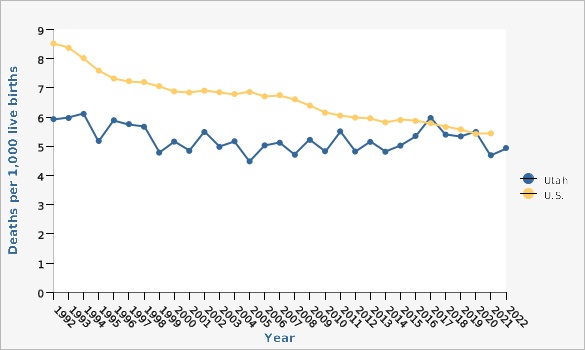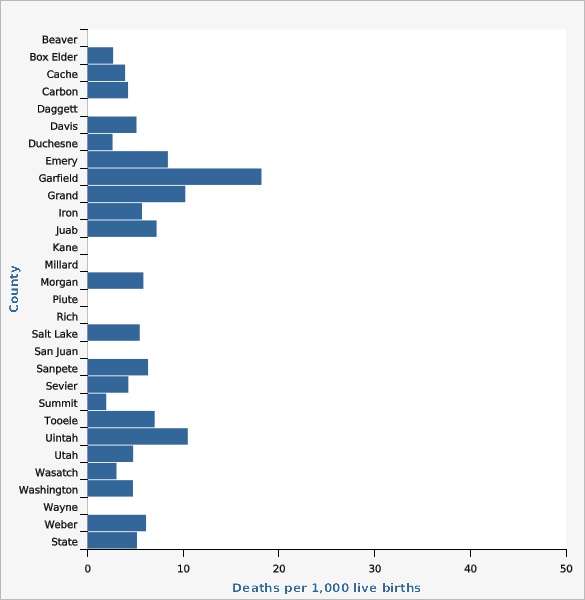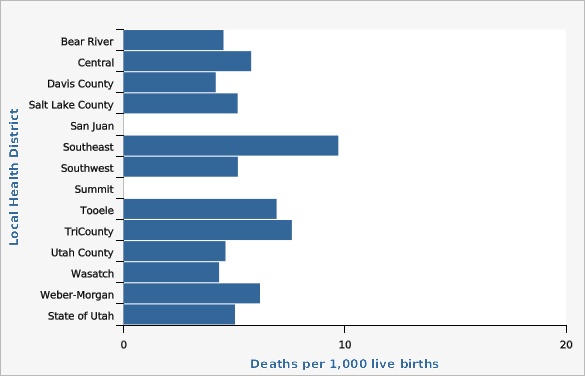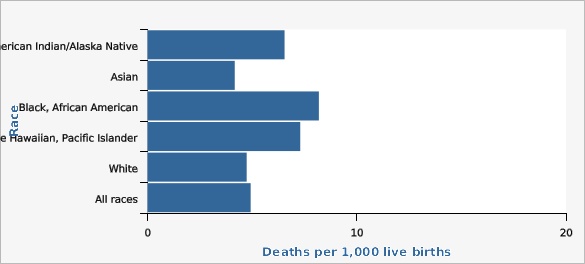Complete Health Indicator Report of Infant Mortality
Definition
Number of infants who died before their first birthday (under 365 days), per 1,000 live births.Numerator
Number of infants who died before their first birthday.Denominator
Total number of live births.Why Is This Important?
The infant mortality rate is an important measure of a nation's health and a worldwide indicator of health status and social well-being. The top four causes of infant mortality in Utah are perinatal conditions (including preterm birth), birth defects, medical conditions of the infant, and sudden unexpected infant death (SUID).Other Objectives
Reduce the racial disparity in infant mortality rates. Healthy People 2030 Objective MICH-02 aims to reduce the infant mortality rate to 5.0 infant deaths per 1,000 live births.How Are We Doing?
The infant mortality rate has declined throughout the past 30 years both locally and nationally. The Utah infant mortality rate in 2022 was 4.9 deaths per 1,000 live births, similar to the 2021 infant mortality rate of 4.7. During 2022, 226 Utah infants died before their first birthday.How Do We Compare With the U.S.?
Historically, the Utah infant mortality rate has been lower than the national rate. In 2021 the Utah infant mortality rate was 4.7 deaths per 1,000 live births, lower than the U.S. rate of 5.4 deaths per 1,000 live births (CDC).What Is Being Done?
The Utah Department of Health and Human Services (DHHS) Maternal and Infant Health Program is currently reviewing data to identify modifiable risk factors for infant mortality, developing appropriate interventions, and promoting preconception and interconception health care for all reproductive aged women.Evidence-based Practices
The Utah Department of Health and Human Services participates in the Utah Women and Newborn Quality Collaborative (UWNQC), a statewide perinatal quality collaborative. This workgroup of clinicians and public health professionals engages in the development and measurement of health care quality indicators and quality improvement projects in the areas of maternal and neonatal health issues.Available Services
'''Baby Your Baby Hotline:''' 1-800-826-9662[[br]] [https://babyyourbaby.org/][[br]] A resource to answer pregnancy related questions and locate services for the public. [[br]] [[br]] '''Utah Women, Infants and Children (WIC) Program:''' [[br]] *[https://wic.utah.gov/ Utah WIC website][[br]] *[https://health.utah.gov/vpms/client/ Utah WIC appointment request][[br]] *[https://wic.utah.gov/locations/ Utah WIC clinic locations][[br]] *Facebook: [https://www.facebook.com/p/WIC-Utah-100064714595124/ WIC Utah][[br]] *Instagram: [https://www.instagram.com/wic_utah/ @wic_utah] [[br]] WIC provides free nutrition education, breastfeeding support, and supplemental foods to pregnant, breastfeeding, and non-breastfeeding postpartum women, infants, and children up to their 5th birthday who have low to moderate incomes.[[br]] [[br]] '''Power Your Life website:''' [https://mihp.utah.gov/power-your-life][[br]] Public education promoting optimal health prior to pregnancy.[[br]] [[br]] Social media for Power Your Life include:[[br]] *Facebook: [http://www.facebook.com/poweryourlifeut poweryourlifeut][[br]] *Instagram: [https://www.instagram.com/Poweryourlifeut @Poweryourlifeut][[br]] [[br]] '''Utah Tobacco Quit Line:''' 1-888-567-8788[[br]][[br]] '''MotherToBaby Utah:'''[[br]] Phone - 1-800-822-2229[[br]] Text - 1-855-999-3525[[br]] Email - expertinfo@mothertobaby.org[[br]] A service to answer questions about what medications are safe during pregnancy and breastfeeding.[[br]] [[br]] Social media for MotherToBaby include:[[br]] *Facebook: [http://www.facebook.com/MotherToBaby][[br]] *Twitter: [http://www.twitter.com/mothertobaby @MotherToBaby][[br]] *Pinterest: [http://www.pinterest.com/MotherToBaby][[br]] [[br]] '''Baby Watch Early Intervention Hotline:''' 1-800-961-4226[[br]] Utah network of services for children, birth to three years of age, with developmental delay or disabilities. [[br]][[br]] '''Utah Women and Newborn Quality Collaborative:''' [https://mihp.utah.gov/uwnqc][[br]] Provider and patient education to improve maternal and neonatal outcomes. [[br]][[br]] '''March of Dimes:''' [http://www.marchofdimes.org][[br]] The mission of the March of Dimes is to improve the health of babies by preventing birth defects, premature birth and infant mortality.[[br]] *Facebook: [https://www.facebook.com/marchofdimes][[br]] *Twitter: [https://www.twitter.com/marchofdimes @MarchofDimes][[br]] *YouTube: [https://www.youtube.com/marchofdimes][[br]] [[br]] '''University of Utah Health Care Parent-to-Parent Support Group:''' 1-801-581-2098[[br]] Support Program for families of high risk/critically ill newborns.[[br]][[br]] '''Share Parents of Utah''': A support program for families experiencing pregnancy loss or death of an infant.[[br]] 801-272-5355[[br]] [http://sputah.org/]Health Program Information
Breastfeeding reduces infant mortality. The "Stepping Up for Utah Babies" Program was developed by the Utah Department of Health and Human Services (DHHS) and partners to recognize Utah hospitals that have taken steps to promote, protect, educate, and encourage breastfeeding in their facilities. Using a learning collaborative model, hospitals can implement 2, 4, 6, 8, or all 10 of the evidence-based steps to successful breastfeeding identified by the World Health Organization and UNICEF ([https://www.babyfriendlyusa.org/for-facilities/practice-guidelines/10-steps-and-international-code/]). A tool kit was adapted and developed outlining best practices, resources, action plans, and barriers to implementing each of the steps. Hospitals that successfully implement each two-step interval (up to 10 steps) will be certified by the Utah DHHS and recognized through media and public celebrations. The Utah DHHS is also a participant in the Sudden Unexpected Infant Death (SUID) Case Registry, a research project hosted by the Centers for Disease Control and Prevention- Division of Reproductive Health. The SUID Case Registry collects data about the circumstances associated with SUID deaths and conducts investigations into these deaths. Collected data enables the state to develop strategies to prevent future deaths.Related Indicators
Relevant Population Characteristics
The following have higher rates of infant mortality: *Mother's age (mothers younger than 20 years) *Mother's educational attainment (high school diploma or less) *Mother being unmarried[[br]] [[br]] The estimated rate of infant mortality is higher for people who identify as Black, NHPI, or AI/AN, but these differences are not statistically significant.Related Relevant Population Characteristics Indicators:
Health Care System Factors
The following health care system factors contribute to a higher risk of infant mortality: *Access to prenatal care *No health insuranceRelated Health Care System Factors Indicators:
Risk Factors
Higher rates of infant mortality are noted among the following: * Maternal inadequate weight gain during pregnancy * Maternal pre-pregnancy BMI (obese prior to pregnancy) * Maternal tobacco use * Less than 6 months between pregnancies * Infant birth weight (less than 2,500 g) * Preterm infant * Multiple gestation (e.g. twins)Related Risk Factors Indicators:
Health Status Outcomes
The following outcomes are related to infant mortality: *Costs associated with low birth weight births *Premature births *Maternal morbidity and mortality *Infant morbidityRelated Health Status Outcomes Indicators:
Graphical Data Views
| Utah vs. U.S. | Year | Deaths per 1,000 live births | Lower Limit | Upper Limit | ||
|---|---|---|---|---|---|---|
Record Count: 61 | ||||||
| Utah | 1992 | 5.9 | 5.2 | 6.7 | ||
| Utah | 1993 | 6.0 | 5.2 | 6.8 | ||
| Utah | 1994 | 6.1 | 5.3 | 6.9 | ||
| Utah | 1995 | 5.2 | 4.5 | 5.9 | ||
| Utah | 1996 | 5.9 | 5.2 | 6.7 | ||
| Utah | 1997 | 5.8 | 5.1 | 6.5 | ||
| Utah | 1998 | 5.7 | 5.0 | 6.4 | ||
| Utah | 1999 | 4.8 | 4.2 | 5.4 | ||
| Utah | 2000 | 5.2 | 4.5 | 5.8 | ||
| Utah | 2001 | 4.8 | 4.2 | 5.5 | ||
| Utah | 2002 | 5.5 | 4.9 | 6.2 | ||
| Utah | 2003 | 5.0 | 4.4 | 5.6 | ||
| Utah | 2004 | 5.2 | 4.6 | 5.8 | ||
| Utah | 2005 | 4.5 | 3.9 | 5.1 | ||
| Utah | 2006 | 5.0 | 4.4 | 5.7 | ||
| Utah | 2007 | 5.1 | 4.5 | 5.8 | ||
| Utah | 2008 | 4.7 | 4.2 | 5.3 | ||
| Utah | 2009 | 5.2 | 4.6 | 5.9 | ||
| Utah | 2010 | 4.8 | 4.2 | 5.5 | ||
| Utah | 2011 | 5.5 | 4.9 | 6.2 | ||
| Utah | 2012 | 4.8 | 4.2 | 5.5 | ||
| Utah | 2013 | 5.2 | 4.5 | 5.8 | ||
| Utah | 2014 | 4.8 | 4.2 | 5.4 | ||
| Utah | 2015 | 5.0 | 4.4 | 5.7 | ||
| Utah | 2016 | 5.4 | 4.7 | 6.0 | ||
| Utah | 2017 | 6.0 | 5.3 | 6.7 | ||
| Utah | 2018 | 5.4 | 4.8 | 6.1 | ||
| Utah | 2019 | 5.3 | 4.7 | 6.0 | ||
| Utah | 2020 | 5.5 | 4.8 | 6.2 | ||
| Utah | 2021 | 4.7 | 4.1 | 5.4 | ||
| Utah | 2022 | 4.9 | 4.3 | 5.6 | ||
| U.S. | 1992 | 8.5 | ||||
| U.S. | 1993 | 8.4 | ||||
| U.S. | 1994 | 8.0 | ||||
| U.S. | 1995 | 7.6 | ||||
| U.S. | 1996 | 7.3 | ||||
| U.S. | 1997 | 7.2 | ||||
| U.S. | 1998 | 7.2 | ||||
| U.S. | 1999 | 7.1 | ||||
| U.S. | 2000 | 6.9 | ||||
| U.S. | 2001 | 6.8 | ||||
| U.S. | 2002 | 6.9 | ||||
| U.S. | 2003 | 6.8 | ||||
| U.S. | 2004 | 6.8 | ||||
| U.S. | 2005 | 6.9 | ||||
| U.S. | 2006 | 6.7 | ||||
| U.S. | 2007 | 6.8 | ||||
| U.S. | 2008 | 6.6 | ||||
| U.S. | 2009 | 6.4 | ||||
| U.S. | 2010 | 6.2 | ||||
| U.S. | 2011 | 6.0 | ||||
| U.S. | 2012 | 6.0 | ||||
| U.S. | 2013 | 6.0 | ||||
| U.S. | 2014 | 5.8 | ||||
| U.S. | 2015 | 5.9 | ||||
| U.S. | 2016 | 5.9 | ||||
| U.S. | 2017 | 5.8 | ||||
| U.S. | 2018 | 5.7 | ||||
| U.S. | 2019 | 5.6 | ||||
| U.S. | 2020 | 5.4 | ||||
| U.S. | 2021 | 5.4 | ||||
Data Notes
U.S. data from National Vital Statistics System [https://www.cdc.gov/nchs/products/databriefs/db456.htm#section_5].Data Sources
- Utah Death Certificate Database, Office of Vital Records and Statistics, Utah Department of Health and Human Services
- Utah Birth Certificate Database, Office of Vital Records and Statistics, Utah Department of Health and Human Services
- National Vital Statistics System, National Center for Health Statistics, U.S. Centers for Disease Control and Prevention
Infant mortality by leading causes of death, Utah, 2013-2022

| Infant cause of death | Year | Deaths per 1,000 live births | Note | |||
|---|---|---|---|---|---|---|
Record Count: 60 | ||||||
| Perinatal Conditions | 2013 | 2.4 | ||||
| Perinatal Conditions | 2014 | 2.3 | ||||
| Perinatal Conditions | 2015 | 2.1 | ||||
| Perinatal Conditions | 2016 | 2.6 | ||||
| Perinatal Conditions | 2017 | 3.0 | ||||
| Perinatal Conditions | 2018 | 2.7 | ||||
| Perinatal Conditions | 2019 | 2.8 | ||||
| Perinatal Conditions | 2020 | 2.4 | ||||
| Perinatal Conditions | 2021 | 2.1 | ||||
| Perinatal Conditions | 2022 | 2.7 | ||||
| Congenital Malformations | 2013 | 1.3 | ||||
| Congenital Malformations | 2014 | 1.5 | ||||
| Congenital Malformations | 2015 | 1.3 | ||||
| Congenital Malformations | 2016 | 1.6 | ||||
| Congenital Malformations | 2017 | 1.5 | ||||
| Congenital Malformations | 2018 | 1.4 | ||||
| Congenital Malformations | 2019 | 1.6 | ||||
| Congenital Malformations | 2020 | 1.5 | ||||
| Congenital Malformations | 2021 | 1.2 | ||||
| Congenital Malformations | 2022 | 1.1 | ||||
| SIDS | 2013 | 0.5 | ||||
| SIDS | 2014 | 0.2 | * | |||
| SIDS | 2015 | 0.4 | ||||
| SIDS | 2016 | 0.3 | ||||
| SIDS | 2017 | 0.4 | ||||
| SIDS | 2018 | 0.4 | ||||
| SIDS | 2019 | 0.2 | * | |||
| SIDS | 2020 | 0.4 | ||||
| SIDS | 2021 | 0.4 | ||||
| SIDS | 2022 | 0.4 | ||||
| Medical Conditions | 2013 | 0.6 | ||||
| Medical Conditions | 2014 | 0.5 | ||||
| Medical Conditions | 2015 | 0.8 | ||||
| Medical Conditions | 2016 | 0.4 | ||||
| Medical Conditions | 2017 | 0.5 | ||||
| Medical Conditions | 2018 | 0.6 | ||||
| Medical Conditions | 2019 | 0.5 | ||||
| Medical Conditions | 2020 | 0.8 | ||||
| Medical Conditions | 2021 | 0.6 | ||||
| Medical Conditions | 2022 | 0.3 | ||||
| Undetermined | 2013 | 0.1 | * | |||
| Undetermined | 2014 | 0.2 | * | |||
| Undetermined | 2015 | 0.2 | * | |||
| Undetermined | 2016 | 0.1 | * | |||
| Undetermined | 2017 | 0.3 | ||||
| Undetermined | 2018 | 0.1 | * | |||
| Undetermined | 2019 | ** | ** | |||
| Undetermined | 2020 | 0.2 | * | |||
| Undetermined | 2021 | 0.2 | * | |||
| Undetermined | 2022 | 0.2 | * | |||
| Unintentional/Accidental | 2013 | 0.2 | * | |||
| Unintentional/Accidental | 2014 | 0.1 | * | |||
| Unintentional/Accidental | 2015 | 0.3 | ||||
| Unintentional/Accidental | 2016 | 0.1 | * | |||
| Unintentional/Accidental | 2017 | 0.1 | * | |||
| Unintentional/Accidental | 2018 | 0.1 | * | |||
| Unintentional/Accidental | 2019 | ** | ** | |||
| Unintentional/Accidental | 2020 | 0.2 | * | |||
| Unintentional/Accidental | 2021 | 0.2 | * | |||
| Unintentional/Accidental | 2022 | ** | ** | |||
Data Notes
*Use caution in interpreting, as the estimate has a relative standard error greater than 30% and does not meet the Utah DHHS standards for reliability. **The estimate has been suppressed because 1) the relative standard error is greater than 50% or 2) the observed number of events is very small and not appropriate for publication.Data Sources
- Utah Death Certificate Database, Office of Vital Records and Statistics, Utah Department of Health and Human Services
- Utah Birth Certificate Database, Office of Vital Records and Statistics, Utah Department of Health and Human Services
| County | Deaths per 1,000 live births | Lower Limit | Upper Limit | Note | ||
|---|---|---|---|---|---|---|
Record Count: 30 | ||||||
| Beaver | ** | ** | ||||
| Box Elder | 2.7 | 1.3 | 4.8 | * | ||
| Cache | 3.9 | 2.8 | 5.3 | |||
| Carbon | 4.2 | 1.4 | 9.9 | * | ||
| Daggett | ** | ** | ||||
| Davis | 5.1 | 4.3 | 6.1 | |||
| Duchesne | 2.6 | 0.7 | 6.7 | * | ||
| Emery | 8.4 | 2.7 | 19.6 | * | ||
| Garfield | 18.2 | 5.9 | 42.4 | * | ||
| Grand | 10.2 | 3.3 | 23.9 | * | ||
| Iron | 5.7 | 3.6 | 8.6 | |||
| Juab | 7.2 | 2.9 | 14.9 | * | ||
| Kane | ** | ** | ||||
| Millard | ** | ** | ||||
| Morgan | 5.8 | 1.6 | 15.0 | * | ||
| Piute | ** | ** | ||||
| Rich | ** | ** | ||||
| Salt Lake | 5.5 | 5.0 | 6.0 | |||
| San Juan | ** | ** | ||||
| Sanpete | 6.3 | 3.3 | 11.0 | |||
| Sevier | 4.3 | 1.6 | 9.3 | * | ||
| Summit | 2.0 | 0.5 | 5.0 | * | ||
| Tooele | 7.0 | 4.9 | 9.7 | |||
| Uintah | 10.5 | 6.9 | 15.2 | |||
| Utah | 4.8 | 4.2 | 5.4 | |||
| Wasatch | 3.0 | 1.1 | 6.6 | * | ||
| Washington | 4.8 | 3.6 | 6.2 | |||
| Wayne | ** | ** | ||||
| Weber | 6.1 | 5.0 | 7.4 | |||
| State | 5.2 | 4.9 | 5.5 | |||
Data Notes
Note: County represents county of infant's residence. *Use caution in interpreting; the estimate has a relative standard error greater than 30% and does not meet the Utah DHHS standards for reliability. **The estimate has been suppressed because 1) the relative standard error is greater than 50% or 2) the observed number of events is very small and not appropriate for publication.Data Sources
- Utah Death Certificate Database, Office of Vital Records and Statistics, Utah Department of Health and Human Services
- Utah Birth Certificate Database, Office of Vital Records and Statistics, Utah Department of Health and Human Services
| Local Health District | Deaths per 1,000 live births | Lower Limit | Upper Limit | Note | ||
|---|---|---|---|---|---|---|
Record Count: 14 | ||||||
| Bear River | 4.5 | 3.2 | 6.2 | |||
| Central | 5.8 | 3.5 | 9.0 | |||
| Davis County | 4.2 | 3.2 | 5.4 | |||
| Salt Lake County | 5.2 | 4.5 | 5.9 | |||
| San Juan | ** | ** | ||||
| Southeast | 9.7 | 5.2 | 16.6 | |||
| Southwest | 5.2 | 3.9 | 6.8 | |||
| Summit | ** | ** | ||||
| Tooele | 6.9 | 4.3 | 10.5 | |||
| TriCounty | 7.6 | 4.5 | 12.0 | |||
| Utah County | 4.6 | 3.9 | 5.4 | |||
| Wasatch | 4.3 | 1.4 | 10.1 | * | ||
| Weber-Morgan | 6.2 | 4.8 | 7.8 | |||
| State of Utah | 5.0 | 4.7 | 5.4 | |||
Data Notes
Note: Local health district based on district of infant's residence. * Use caution in interpreting, as the estimate has a relative standard error greater than 30% and does not meet the Utah DHHS standards for reliability. **The estimate has been suppressed because 1) the relative standard error is greater than 50% or 2) the observed number of events is very small and not appropriate for publication.Data Sources
- Utah Death Certificate Database, Office of Vital Records and Statistics, Utah Department of Health and Human Services
- Utah Birth Certificate Database, Office of Vital Records and Statistics, Utah Department of Health and Human Services
| Race | Deaths per 1,000 live births | Lower Limit | Upper Limit | Note | ||
|---|---|---|---|---|---|---|
Record Count: 6 | ||||||
| American Indian/Alaska Native | 6.6 | 2.8 | 12.9 | * | ||
| Asian | 4.2 | 2.3 | 6.9 | |||
| Black, African American | 8.2 | 4.7 | 13.3 | |||
| Native Hawaiian, Pacific Islander | 7.3 | 3.8 | 12.8 | |||
| White | 4.7 | 4.4 | 5.2 | |||
| All races | 4.9 | 4.6 | 5.3 | |||
Data Notes
*Use caution in interpreting, as the estimate has a relative standard error greater than 30% and does not meet the Utah DHHS standards for reliability.Data Sources
- Utah Death Certificate Database, Office of Vital Records and Statistics, Utah Department of Health and Human Services
- Utah Birth Certificate Database, Office of Vital Records and Statistics, Utah Department of Health and Human Services
References and Community Resources
Maternal and Infant Health Program - Utah Department of Health and Human Services (Utah DHHS)[[br]] [http://mihp.utah.gov][[br]] [[br]] Maternal and Child Health Bureau - Health Resources and Services Administration (HRSA)[[br]] [http://mchb.hrsa.gov][[br]] [[br]] Reproductive Health - Centers for Disease Control and Prevention (CDC)[[br]] [http://www.cdc.gov/reproductivehealth/index.htm][[br]] [[br]] March of Dimes[[br]] [http://www.marchofdimes.com/]More Resources and Links
Evidence-based community health improvement ideas and interventions may be found at the following sites:- Centers for Disease Control and Prevention (CDC) WONDER Database, a system for disseminating public health data and information.
- United States Census Bureau data dashboard.
- Utah healthy Places Index, evidence-based and peer-reviewed tool, supports efforts to prioritize equitable community investments, develop critical programs and policies across the state, and much more.
- County Health Rankings
- Kaiser Family Foundation's StateHealthFacts.org
- Medical literature can be queried at PubMed library.
Page Content Updated On 02/21/2024,
Published on 03/14/2024




